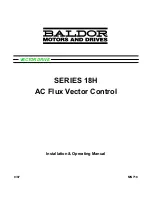
10-1
10. Troubleshooting, Fault Diagnostics and Maintenance
10.1 General
Inverter fault detection and early warning / self-diagnosis function. When the inverter detects a fault, a fault
message is displayed on the keypad.
When the inverter detects a warning / self-diagnostics error, the digital operator will display a warning or
self-diagnostic code, the fault output does not energize in this case. Once the warning is removed, the system will
automatically return to its original state.
10.2 Fault Detection Function
When a fault occurs, please refer to Table 10.2.1 for possible causes and take appropriate measures.
Use one of the following methods to restart:
1. Set one of multi-function digital input terminals (03-00 ~ 03-05) to 17 (Fault reset); activate input
2. Press the reset button on the keypad.
3. Power down inverter wait until keypad goes blank and power-up the inverter again.
When a fault occurs, the fault message is stored in the fault history (see group 12 parameters).
Table 5.2.1 Fault information and possible solutions
LED display
Description
Cause
Possible solutions
OV
Over voltage
DC bus voltage
exceeds the OV
detection level:
410Vdc: 230V class
820Vdc: 460V class
(For 440V class, if
input voltage 01-14
is set lower than
460V, the OV
detection value will
is decreased to
700Vdc).
Deceleration time set too short, resulting in
regenerative energy flowing back from motor
to the inverter.
The inverter input voltage is too high.
Use of power factor correction capacitors.
Excessive braking load.
Braking transistor or resistor defective.
Speed search parameters set incorrectly.
Increase deceleration time
Reduce input voltage to comply
with the input voltage
requirements or install an AC
line reactor to lower the input
voltage.
Remove the power factor
correction capacitor.
Use dynamic braking unit.
Replace braking transistor or
resistor.
Adjust speed search
parameters.
Downloaded from Dealers Industrial Equipment -- Visit
















































